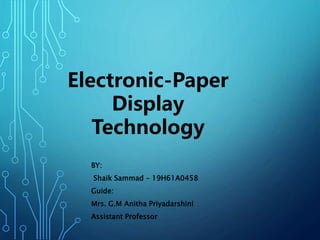
E-Paper Technology ppt.pptx
- 1. BY: Shaik Sammad – 19H61A0458 Guide: Mrs. G.M Anitha Priyadarshini Assistant Professor Electronic-Paper Display Technology
- 2. CONTENT Introduction History Technologies Comparison of e-paper & LCD Applications Advantages & Disadvantages Conclusion
- 3. INTRODUCTION • E-Paper is also called Electronic Paper or Electronic ink Display. • The first E-Paper was developed in 1974’s by “Nicholas K Sheridon” at Xerox’s Palo Alto Research Centre. • It is a display unit. • E-Paper is flexible. • E-paper have a wide viewing angle. • A digital pen is also used to create handwritten document.
- 4. HISTORY • Developed in the 1970’s by Nick Sheridon at Xerox's Palo Alto Research Center. • The first electronic paper was called Gyricon. • At the FPD 2008 exhibition, Japanese company Soken demonstrated a wall with electronic wall-paper using this technology. • Random example: • USB flash drive with • E Ink-implemented • capacity meter of available • flash memory.
- 5. TECHNOLOGIES PROPOSED SO FAR Gyricon Electrophoretic display Electrofluidic display Interferometric modulator (Mirasol)
- 6. GYRICON • It was the first electronic paper and was developed in 1970’s. • Consists of polyethylene spheres having diameter between 75-106 micrometers. • Each sphere is a janus particle composed of negatively charged black plastic on one side and positively charged white plastic on the other (each bead is thus a dipole). • These spheres are embedded in transparent silicone made sheet, with each sphere suspended in a bubble of oil so that they can rotate freely. • The polarity of the voltage applied to each pair of electrodes then determines whether the white or black side is face-up, thus giving the pixel a white or black appearance.
- 7. • The spheres of the Gyricon display are trapped in the oil-filled cavities of an elastomer. Positioning them with a positive or negative voltage puts them into the reflecting [left] or light-absorbing [right] black state. Prototypes have been fabricated at Xerox' PARC.
- 8. ELECTROPHORETIC DISPLAY • The electronic ink display from E Ink is based on encapsulated electrophoretics --microcapsules containing many tiny white pigment chips, or particles, that are suspended in a blue-black liquid dye. • Applying an electric field moves the particles about; the microcapsules can be switched into the reflecting [left] or absorbing [right] state by applying a positive or negative voltage across the indium-tin oxide (ITO) electrodes.
- 10. ELECTROPHORETIC DISPLAY • Any kind of electrophoretic display relies on electrostatic migration of light-scattering particles in a dyed colloidal suspension. • When a positive voltage is applied, the particles migrate electrostatically toward the electrode on the viewer side. • If white light-scattering particles are used, a near-Lambertian reflection can be obtained. • When a negative voltage is applied, the particles move to the electrode on the side away from the viewer and become hidden behind the dye; the viewer sees the color of the dye. • Once migration occurs under either polarity and the voltage is removed, the white particles stay in place, creating a bistable memory device.
- 12. INTERFEROMETRIC MODULATOR (MIRASOL) • Technology used in electronic visual displays that can create various colors via interference of reflected light. • The color is selected with an electrically switched light modulator comprising a microscopic cavity that is switched on and off using driver integrated circuits similar to those used to address liquid crystal displays (LCD).
- 13. MIRASOL DISPLAY
- 14. COMPARISON OF E-PAPER & LCD Electronic Ink Display Liquid Crystal Display Wide viewing angle Best image only from one position Black on paper white Gray on gray Readable in sunlight Can be difficult to see Holds image without power drain Required power to hold images Plastic or glass Glass only Light Weight Power supply and glass make LCDs relatively heavy Thin (~1 mm) Thick (~7 mm)
- 15. ADVANTAGES • Paper-like readability • Sunlight and non-uniform light visibility • High reflectivity, high contrast & resolution • Viewing angle ~180 degree • Highly flexible • Ultra-Low Power Consumption • Long-term Bistable Image: content preserved without power • Prolonged battery life
- 16. DISADVANTAGES • Full color implementation- not yet. • Implementation of video on it- not yet. • Flexibility of the e-paper such that it can be rolled or folded- not yet. • Develop it as such that it will reflect infra red rays and the documents can be read by using night vision camera only, or so that it can be used by military and security purposes.
- 17. APPLICATIONS • Electronic Book • Electronic Newspaper • Mobile display • Computer monitor
- 18. CONCLUSION • Researches found that in just few years this technology can replace paper in many situations, leading us to think of a truly paperless world.
- 19. THANK YOU